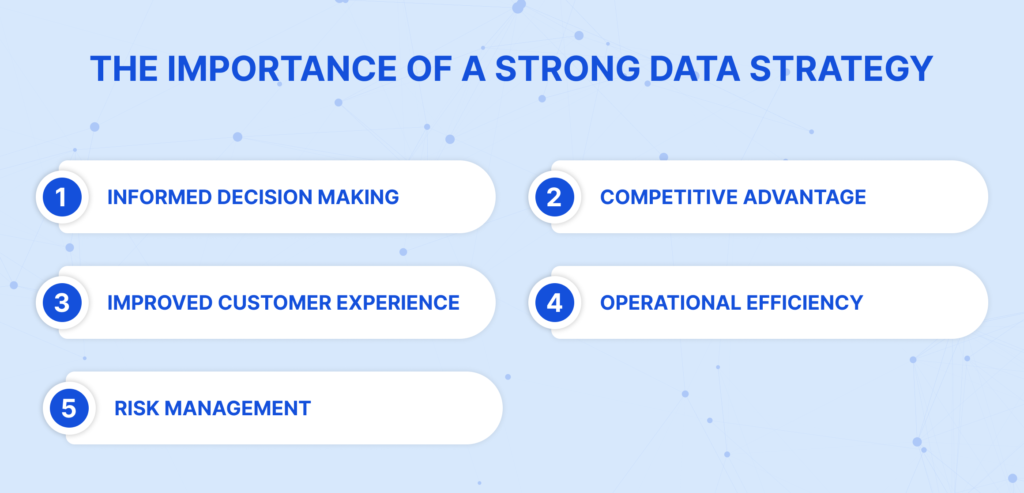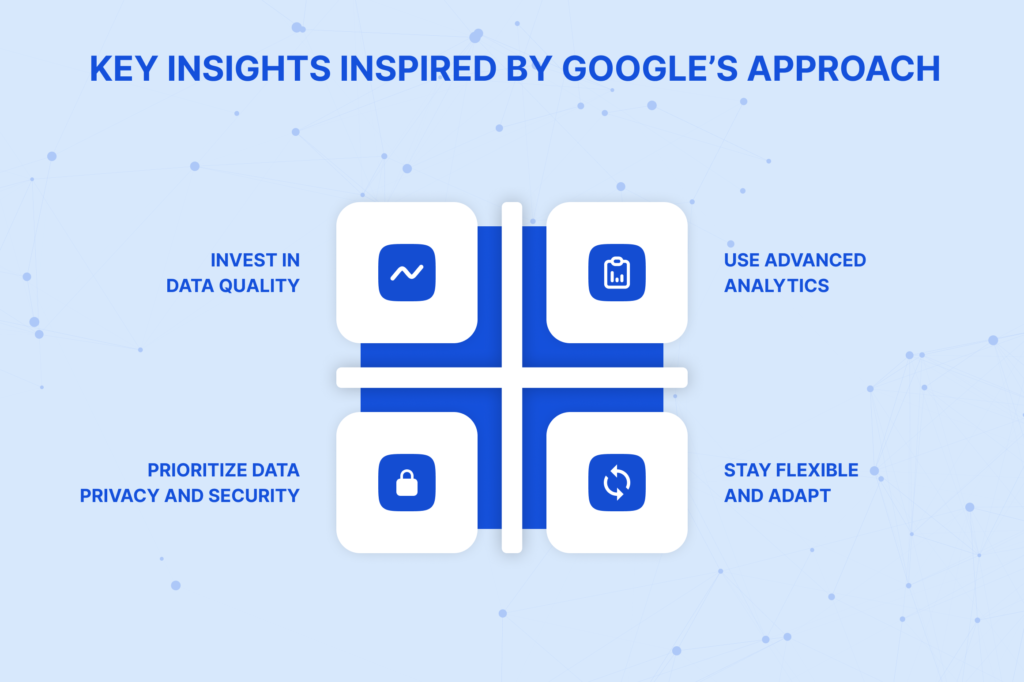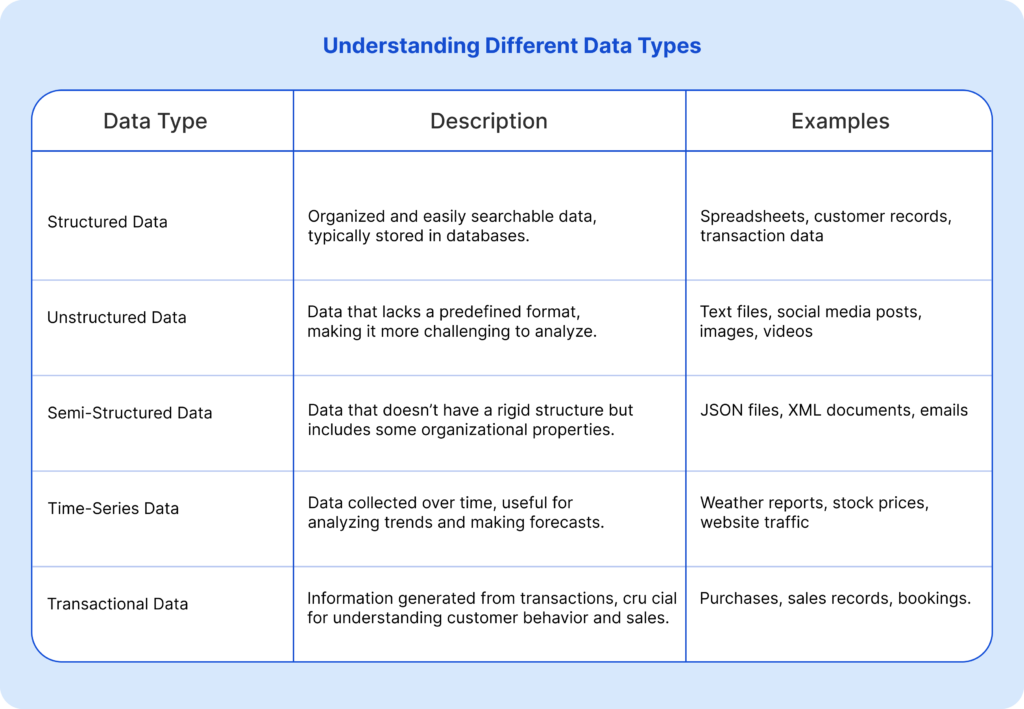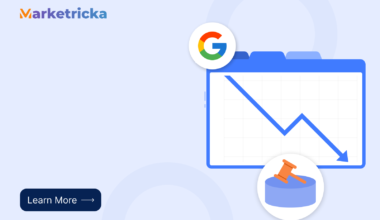Summary :
In today’s digital landscape, data isn’t just a collection of numbers; it’s a powerful asset that can shape your business’s future. As companies compete for attention and loyalty, implementing effective data strategy practices becomes essential. By using insights from Google, you can refine how you collect, analyze, and utilize data to truly understand your customers and their needs.
Imagine being able to predict what your customers want before they even know it themselves. With a smart data strategy, you can make this a reality. By understanding how to collect the right information and interpret it well, you can customize your products and services to meet their needs. This approach not only boosts customer happiness but also builds trust and loyalty, making your audience feel valued and understood.
In this blog, we’ll explore practical ways to enhance your data strategy with effective data strategy practices. We’ll share easy tips that can turn your data into meaningful insights you can act on. Whether you run a small business or work for a big company, these strategies will empower you to make smart decisions that lead to growth and success. Join us on this journey to discover how to unlock the full potential of your data and boost your brand in a competitive marketplace!
Why Does a Strong Data Strategy Matters?
In a world where every click and interaction creates data, knowing how to use this information can give a business an edge. A solid data strategy isn’t just a requirement; it’s a way to discover insights that promote growth and new ideas.
By effectively using data, businesses can turn challenges into opportunities, making effective data strategy practices essential for any organization looking to move forward. Here are some key reasons why a strong data strategy matters:

- Informed Decision Making : With a robust data strategy, organizations can utilize data analytics to make informed decisions. This leads to better strategic planning and enhances overall business performances.
- Competitive Advantage : Companies with effective data strategies can identify market trends and customer preferences more quickly than their competitors. This allows them to stay ahead in the market.
- Improved Customer Experience : A strong data strategy enables businesses to understand their customers better. By analyzing data, companies can customize their offerings and communication, creating personalized experiences that enhance customer satisfaction and loyalty.
- Operational Efficiency : By optimizing data management processes, organizations can reduce costs and improve operational efficiency. A well-defined data strategy helps streamline data collection, storage, and analysis, making processes more efficient.
- Risk Management : By looking at past data and trends, organizations can predict possible problems and create plans to deal with them in advance.
What Google Teaches Us About Data Strategy?
To make the most of their data, organizations must keep improving their data strategies. Here are some key insights inspired by Google’s approach:

1) Invest in Data Quality
Ensure that the data collected is accurate, consistent, and relevant. Implement data cleaning processes and regular audits to maintain high data quality.
2) Use Advanced Analytics
Utilize machine learning and AI to gain deeper insights from your data. Google uses sophisticated algorithms to analyze vast datasets, enabling smarter decision-making.
3) Prioritize Data Privacy and Security
In an era of increasing data leaks, prioritize the safety of sensitive information. Implement strong security measures and follow regulations to build trust with your clients.
4) Stay Flexible and Adapt
The data landscape is always changing. Regularly review your strategy and adjust it based on new technologies and market trends.
Understanding Different Data Types
To improve your data strategy, it’s essential to understand the various types of data you can work with. Each type serves a unique purpose and can significantly impact your analysis and decision-making, especially when applying effective data strategy practices. Here are the main categories of data:

Collecting Data the Google Way: Effective Data Strategy Practices
Collecting data effectively is essential for any organization looking to enhance its data strategy. By following effective data strategy practices, you can implement Google’s best practices to gather valuable data efficiently. Here are some key strategies to consider:

1) Define Clear Objectives
Start by identifying what you want to achieve with your data collection. Clearly defined objectives will guide the type of data you need to collect and help ensure that the data gathered aligns with your business goals.
2) Utilize Multiple Sources
Diversify your data sources to gain a comprehensive view.
This can include customer surveys, social media insights, web analytics and sales data. By using various sources, you can enrich your data and uncover deeper insights.
3) Ensure Data Quality
Focus on collecting high-quality data. This means ensuring accuracy, consistency, and relevance. Implement validation checks during the data collection process to minimize errors and ensure that the data is trustworthy.
4) Use Automation Tools
Use automated tools and technologies to streamline data collection. Google offers various tools, such as Google Analytics and Google Forms, which can simplify the gathering process and reduce manual effort.
5) Prioritize Privacy and Compliance
Be clear about how you collect and use data. Always get consent from users and follow regulations like GDPR. This builds trust with customers and protects your business.
6) Regularly Review and Update Data
Data can become outdated over time, so it’s important to review and refresh your data regularly. Establishing a routine for data audits is one of the effective data strategy practices that ensures your information remains relevant and useful for decision-making.
7) Engage Your Audience
Involve your customers in the data collection process. Use surveys, polls, and feedback forms to gather insights directly from your audience. Engaging with customers not only provides valuable data but also enhances their experience.
8) Analyze and Interpret
Once the data is collected, take the time to analyze and interpret it effectively. Use data visualization tools to make sense of complex data sets, helping you identify trends and patterns that inform your strategies.
Tools and Resources
To support your data strategy, consider using tools like :
- Tableau : For Data Visualization
- Microsoft Power BI : For Business Analytics
- SurveyMonkey : For Collecting Customer Feedback
Future Trends in Data Strategy
Stay ahead by keeping an eye on trends like predictive analytics, real-time data usage and the integration of AI in data processing.
1) Predictive Analytics
- What it is : Using Historical data to make smart predictions about the future.
- Why it matters : Helps businesses anticipate customer needs and market changes, allowing for proactive decision-making.
2) Real-Time Data Usage
- What it is : Analyzing data as it happens instead of waiting for reports.
- Why it matters : Enables quick responses to trends and issues, keeping companies competitive.
3) AI Integration
- What it is : Incorporating artificial intelligence into data processing to automate tasks and gain deeper insights.
- Why it matters : Increases efficiency and uncovers hidden patterns, leading to better strategies and outcomes.
Conclusion
In conclusion, boosting your data strategy is a game-changer for your business. By putting the ideas from this blog into action, including effective data strategy practices, you can truly harness the power of your data.
Start by focusing on collecting high-quality information that helps you understand your customers better. Don’t forget to involve your audience—ask for their feedback and insights. This not only enriches your data but also makes your customers feel valued and heard. So, why wait? Begin implementing these strategies today and watch your business transform. Your data isn’t just numbers; it’s a treasure trove of opportunities waiting for you to explore.
Divyesh Savaliya
As an enthusiastic content writer by profession and an eager researcher, I delve into diverse subject matters to create the best SEO-optimized content pieces ready to captivate audiences







2 comments
My brother suggested I might like this website He was totally right This post actually made my day You cannt imagine just how much time I had spent for this information Thanks
I’m so glad to hear that! It really means a lot that the post helped you out. Sometimes, finding the right info can take a while, but I’m happy you found it here!
If you ever need more tips or have any questions, feel free to reach out. Thanks for the kind words – they made my day too!